Ikana: Hyrule’s Shadow
Posted on September 09 2011 by Axle D. Wilder
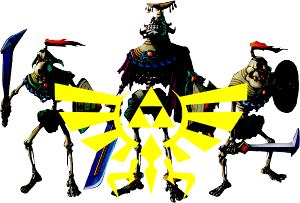 I’ve made no secret of my love for Majora’s Mask. I’ve stated numerous times across all my videos and articles that it’s my favorite Zelda game, and although I haven’t written about it recently, that hasn’t changed. Of all the things I love about Majora’s Mask, it’s actually a single region that stands out the most for me. That region is Ikana Canyon, the last full area that is visited in the game. Part of my affinity for this region stems from it being largely themed off of undead enemies and other dark themes that I’ve always been fond of, but there’s much more to Ikana than it seems at first. This region used to be the site of the lost Kingdom of Ikana; the remnants of it can be seen in Ancient Castle of Ikana as well as the Stalfos and Stalchildren who are the restless souls of its royalty and soldiers.
I’ve made no secret of my love for Majora’s Mask. I’ve stated numerous times across all my videos and articles that it’s my favorite Zelda game, and although I haven’t written about it recently, that hasn’t changed. Of all the things I love about Majora’s Mask, it’s actually a single region that stands out the most for me. That region is Ikana Canyon, the last full area that is visited in the game. Part of my affinity for this region stems from it being largely themed off of undead enemies and other dark themes that I’ve always been fond of, but there’s much more to Ikana than it seems at first. This region used to be the site of the lost Kingdom of Ikana; the remnants of it can be seen in Ancient Castle of Ikana as well as the Stalfos and Stalchildren who are the restless souls of its royalty and soldiers.
This kingdom has an entire backstory to it, only some of which is actually told to you during the game. Many questions are left unanswered and it’s clear that there is an entire tale about Ikana left untold. Still, from the game itself we can glean many interesting bits of information and between Ikana itself, the deadly Stone Tower Temple, and the villain of the game, Majora, we can start to get a pretty fascinating picture.
A long time ago I came to two major conclusions about Ikana and the areas contained within. One, Stone Tower, stated to be the source of Ikana’s dark curse, is a shrine to the entity known as Majora. And two, Ikana itself is Termina’s parallel to the Kingdom of Hyrule.
Ikana bears many similarities to Hyrule. To start, it is the only location within the parallel dimension of Termina, barring the Deku Palace, that is an actual kingdom. There was a castle, a monarchy, and a royal family. It’s unclear how this kingdom functioned or what it was like when it was around, but just the fact that it exists and was populated (probably) by a race of humans is a major similarity to Hyrule. As for it only being a small kingdom within a larger world, well… That’s always been true of Hyrule as well. The Oracle series and Twilight Princess clearly illustrate that Hyrule is only a kingdom surrounded by neighboring lands.
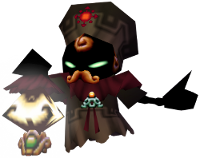 The next major point in the argument for Ikana being Termina’s Hyrule is its characters. Only a handful of the characters that appear in Ikana Canyon are relevant to the ancient kingdom – the rest being merely people who arrived in more recent times like Pamela and her father or Sakon – but they are telling. The king, Igos du Ikana, ruled Ikana Kingdom before its fall, and is met in the game as the boss of the Ancient Castle of Ikana along with his two Stalfos bodyguards. His last name is that of his kingdom, much like Daphnes Nohansen Hyrule. Aside from being an interesting character, acting as the general of Ikana’s army, Skull Keeta has no relevance to Ikana’s connection to Hyrule, but the Composer Brothers Sharp and Flat, on the other hand, are a different matter. Sharp and Flat appear in Ocarina of Time as two legendary composers who served the Royal Family in life. They died in defiance of Ganondorf, and thus are encountered as Poes when Link meets them, giving Link the Sun’s Song. Termina is a parallel world containing parallel versions of many of the people of Hyrule. As far as game design reasons go, Sharp and Flat were likely reintroduced in Ikana specifically because they were ghosts and it was an undead-themed region, but when you examine it from the plot perspective, it is very telling because Sharp and Flat in Ocarina of Time served the Royal Family of Hyrule, whereas in Termina they served the Royal Family of Ikana, complete with the Triforces on their clothes now being replaced by a symbol that looks similar to Igos du Ikana’s brooch and also appears throughout Ikana Castle and Stone Tower.
The next major point in the argument for Ikana being Termina’s Hyrule is its characters. Only a handful of the characters that appear in Ikana Canyon are relevant to the ancient kingdom – the rest being merely people who arrived in more recent times like Pamela and her father or Sakon – but they are telling. The king, Igos du Ikana, ruled Ikana Kingdom before its fall, and is met in the game as the boss of the Ancient Castle of Ikana along with his two Stalfos bodyguards. His last name is that of his kingdom, much like Daphnes Nohansen Hyrule. Aside from being an interesting character, acting as the general of Ikana’s army, Skull Keeta has no relevance to Ikana’s connection to Hyrule, but the Composer Brothers Sharp and Flat, on the other hand, are a different matter. Sharp and Flat appear in Ocarina of Time as two legendary composers who served the Royal Family in life. They died in defiance of Ganondorf, and thus are encountered as Poes when Link meets them, giving Link the Sun’s Song. Termina is a parallel world containing parallel versions of many of the people of Hyrule. As far as game design reasons go, Sharp and Flat were likely reintroduced in Ikana specifically because they were ghosts and it was an undead-themed region, but when you examine it from the plot perspective, it is very telling because Sharp and Flat in Ocarina of Time served the Royal Family of Hyrule, whereas in Termina they served the Royal Family of Ikana, complete with the Triforces on their clothes now being replaced by a symbol that looks similar to Igos du Ikana’s brooch and also appears throughout Ikana Castle and Stone Tower.
And finally there’s one other crucial piece of evidence in support of Ikana’s connection to Hyrule: The Triforce. The Royal Family of Hyrule were the protectors of the Triforce’s legend. They knew the tale of the creation of Hyrule and of the Triforce. After the war which united Hyrule, the kingdom was established and the Triforce guarded. Aside from those who actually seek the Triforce, which in all cases has been evil men like Ganondorf, the only people who ever deal with it in any way are the Royal Family.
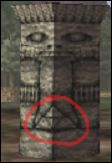 Within Termina, however, the Triforce rarely appears. And why would it appear constantly? The Goddesses are not mentioned in this world. The villain’s goal is not to seek the Triforce. It only appears at the beginning of the game when Link enters Termina for the first time – the symbolism of this sequence is debated – and in Ikana. Particularly within Stone Tower on the underside of the moving blocks used to access the Temple (visible when the area is flipped), where it appears to be dominated by a demonic figure, located at the tip of its tongue between its legs. It seems to appear in an unusual fashion that indicates a mocking of the symbol, as many have suggested, but even if that’s true it still calls into question the Triforce’s relevance to the world of Termina. It’s probable that the Triforce symbol still originates from the Kingdom of Ikana itself, as it does appear once outside of the tower, on pillars in the section of Termina Field that leads to Ikana Canyon, which seems to strongly resemble the same image of a demon dominating the Triforce. There are no other likely sources within Termina that the Triforce could have originated from, really, so it was likely adapted into use within Stone Tower for reasons that can only be speculated. The demonic imagery itself may be just Ikana’s unique heraldry, sort of like how Hyrule has the Royal Crest of the Triforce and a bird, or the blasphemy theories might be accurate.
Within Termina, however, the Triforce rarely appears. And why would it appear constantly? The Goddesses are not mentioned in this world. The villain’s goal is not to seek the Triforce. It only appears at the beginning of the game when Link enters Termina for the first time – the symbolism of this sequence is debated – and in Ikana. Particularly within Stone Tower on the underside of the moving blocks used to access the Temple (visible when the area is flipped), where it appears to be dominated by a demonic figure, located at the tip of its tongue between its legs. It seems to appear in an unusual fashion that indicates a mocking of the symbol, as many have suggested, but even if that’s true it still calls into question the Triforce’s relevance to the world of Termina. It’s probable that the Triforce symbol still originates from the Kingdom of Ikana itself, as it does appear once outside of the tower, on pillars in the section of Termina Field that leads to Ikana Canyon, which seems to strongly resemble the same image of a demon dominating the Triforce. There are no other likely sources within Termina that the Triforce could have originated from, really, so it was likely adapted into use within Stone Tower for reasons that can only be speculated. The demonic imagery itself may be just Ikana’s unique heraldry, sort of like how Hyrule has the Royal Crest of the Triforce and a bird, or the blasphemy theories might be accurate.
It’s interesting to note that, if this theory is correct, that this means that Majora’s Mask offers us a glimpse at what Hyrule would be like without its kingdom, without the protection of the Triforce and without the Hylian religion and legend of the Goddesses. If Hyrule were to lose these things, could it become like Ikana?
Then there’s the matter of Majora’s relevance to Stone Tower, and by extension, Ikana Kingdom. Majora’s nature itself is left pretty much a mystery. All we know is Majora’s Mask, a mask possessed by some kind of entity, was used by an ancient tribe in hexing rituals. This tribe is never named or elaborated upon – it’s only said that they eventually came to fear the mask and sealed it:
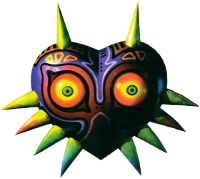 I’ve discussed before that I believe the “Ancient Tribe” to be Termina’s parallel to the Dark Tribe hinted at in Zelda history, and also why I think that the Dark Tribe and the Dark Interlopers of Twilight Princess are one and the same. If that’s the case, then it must be mentioned that the Dark Tribe sought the Triforce, and since the Triforce is referenced within Stone Tower, that’s a notable connection between the Ancient Tribe (and by extension Majora) and Stone Tower.
I’ve discussed before that I believe the “Ancient Tribe” to be Termina’s parallel to the Dark Tribe hinted at in Zelda history, and also why I think that the Dark Tribe and the Dark Interlopers of Twilight Princess are one and the same. If that’s the case, then it must be mentioned that the Dark Tribe sought the Triforce, and since the Triforce is referenced within Stone Tower, that’s a notable connection between the Ancient Tribe (and by extension Majora) and Stone Tower.
Stone Tower itself is the source of the “curse of Ikana”, as I call it. The evil that plagues the kingdom and drove its inhabitants to madness and then undeath. Igos du Ikana states when the curse began:
Prior to the battle against Igos, he refers to Ikana as a land where there is only darkness, accusing Link of bringing light there, and later crediting Link with using that light to liberate him from that darkness. He then refers to that darkness as being born of Stone Tower, once again. One has to wonder about the darkness from Stone Tower… Wasn’t Majora’s Mask sealed in shadow?

Then there’s the symbols within the tower. Aside from the Triforce symbols dominated by the demonic figure, we see symbols of Majora itself. Entering the dungeon in its inverted state, the first room contains a structure that strongly resembles Majora’s final form, Majora’s Wrath, and the dungeon entrance itself could be said to also bear resemblance to the actual mask, particularly in how it is colored in oddly bright tones compared to the area around it, and it also resembles a tribal mask. A symbol of Majora’s Mask also appears within the strange desert realm where you fight Twinmold.
Why does Majora’s likeness appear all throughout the dungeon? Images of the mask never appear anywhere else in the game except on the pads that warp to a dungeon’s boss chamber (clearly a gameplay element rather than a plot one) and the blocks that you can push to complete puzzles, which is likely meaningless as all the blocks everywhere in Ocarina of Time bore the Gerudo symbol for no apparent reason either (although interestingly, in Ocarina of Time the Gerudo area was the last region of the game, just as Ikana is for Majora’s Mask; consistently both games have applied a symbol crucial to their final area to their pushable blocks). Thus Stone Tower is the only location with noteworthy depictions of Majora’s Mask. Ikana is also noteworthy as the only region the Skull Kid hasn’t touched… at all. Upon putting on Majora’s Mask, the Skull Kid is corrupted by its evil power. And that power, filtered through his childlike personality, is used for cruel mischief. Many people throughout Clock Town, Woodfall, Snowhead, and Great Bay have been victims of Majora’s malevolent pranks. Why is it that Ikana is the only region in the entire game where the Skull Kid has not been? No one in Ikana suffers from the Skull Kid’s pranks. To be fair, there is actually a reference to the Skull Kid:
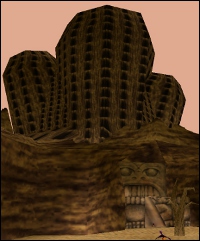 But this quote itself doesn’t make any sense. “Someone” opened the door to Stone Tower, but that was ages ago before the fall of the now ancient Ikana Kingdom, so it couldn’t have been the work of the Skull Kid. This only makes sense if you consider one of two things… One, the evil from Stone Tower was unleashed far more recently, but that would indicate the fall of Ikana was completely unrelated, even though Igos referred to the two events in the same sentence and likened them to each other. Two, the curse of Stone Tower is unrelated to the raising of the dead, but that also makes little sense because if that is the case then it’s not a very impressive curse, and additionally upon the completion of Stone Tower we literally see the curse dissipate. To be completely honest, I don’t think Nintendo was thinking it through too carefully when they had Sharp say this, but to rationalize it within the plot, he could simply be referring to a previous wearer of Majora’s Mask, or more likely he’s simply blurring past events caused by Majora and those caused by the Skull Kid together as they both involve Majora’s Mask. Either way, it’s clear Ikana succumbed to Majora’s evil long ago. Ikana is the only region where the major problem is quite literally caused by pure evil, and the source of that evil is decorated with the mark of Majora’s Mask.
But this quote itself doesn’t make any sense. “Someone” opened the door to Stone Tower, but that was ages ago before the fall of the now ancient Ikana Kingdom, so it couldn’t have been the work of the Skull Kid. This only makes sense if you consider one of two things… One, the evil from Stone Tower was unleashed far more recently, but that would indicate the fall of Ikana was completely unrelated, even though Igos referred to the two events in the same sentence and likened them to each other. Two, the curse of Stone Tower is unrelated to the raising of the dead, but that also makes little sense because if that is the case then it’s not a very impressive curse, and additionally upon the completion of Stone Tower we literally see the curse dissipate. To be completely honest, I don’t think Nintendo was thinking it through too carefully when they had Sharp say this, but to rationalize it within the plot, he could simply be referring to a previous wearer of Majora’s Mask, or more likely he’s simply blurring past events caused by Majora and those caused by the Skull Kid together as they both involve Majora’s Mask. Either way, it’s clear Ikana succumbed to Majora’s evil long ago. Ikana is the only region where the major problem is quite literally caused by pure evil, and the source of that evil is decorated with the mark of Majora’s Mask.
I think that all this is far too much to just write these off as individual, unrelated bits of meaningless information. It matches up exactly. Clearly, Majora’s Mask was important to Stone Tower. It’s even likely that Stone Tower was erected in Majora’s honor, due to how much it seems to be revered within the tower, or at the very least built by the tribe that used the mask, since it seems to predate even the Kingdom of Ikana.
The power of Majora, the evil curse of Ikana. It is a darkness that corrupts the land and makes it into the place of journey’s end. The last stop before the showdown against Majora itself. It’s a perfect setting, the birthplace of the villain, just like how in Ocarina of Time you visit Ganondorf’s home and complete the Spirit Temple before moving on to the finale. Ikana is a compelling region because of all of its mysteries. Majora’s Mask is a game of mysteries, really, when you come down to it. There is so much symbology and so much left only hinted at. Ikana is the same. There is an amazing story that is never told, with bits and pieces left for us to consider and come to conclusions like these. Among what I’ve already discussed, there are other mysterious characters and locations within the region, such as the Gibdos or the Poe Collector, or the Secret Shrine. Even the Garo, the mysterious enemies of Ikana that came from another land.
Mysteries like these and the theories we concoct to explain them, among other things, are why I love Ikana so much. It is a fascinating, compelling region and a great tale. Like Majora’s Mask in general, I truly think it’s best left untold because it’s the mystery that makes it so great. Ikana is the mysterious, dark land of Majora’s Mask, populated by pure evil and the final destination of the game. A land where there is nothing but darkness. Hyrule’s Shadow.




